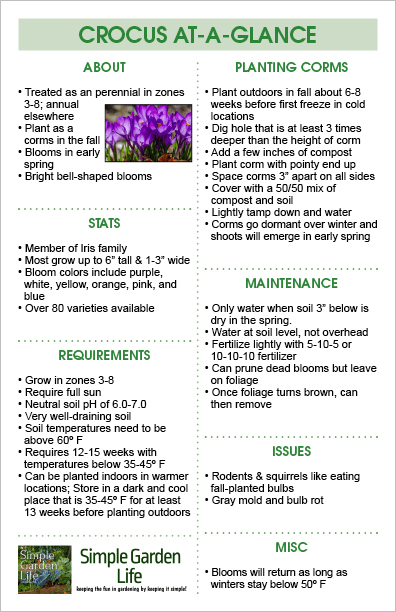Crocus flowers are a great addition to any garden landscape. Their bright bell-shaped blooms help to welcome in the warmer spring weather. Follow these simple steps so you can learn how to grow crocus flowers and add them to your landscape.
Crocuses are small flowers but they are mighty and easy to grow. They are a member of the iris family. Although they are commonly referred to as bulbs, crocuses actually grow from corms. The main difference between a bulb and a corm is that bulbs are a collection of modified leaf matter while the corm is modified stem matter. Both are treated the same way when it comes to planting, however.
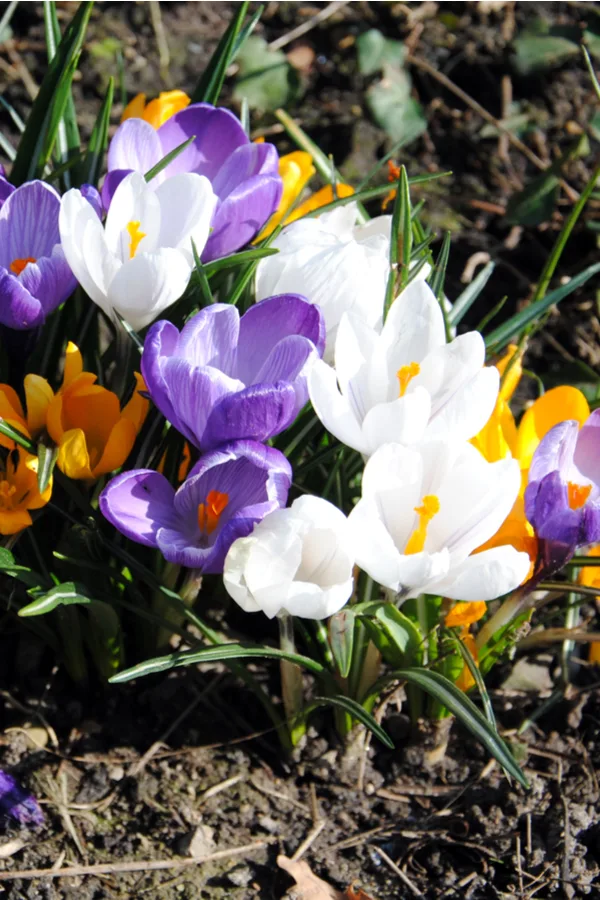
In many locations with four seasons, crocuses are the first flower to mark the arrival of spring. It’s not uncommon to see their little shoots of green poking up through a cold white layer of snow even in early March.
These early spring bloomers have a hardiness growing zone of 3 to 8. You can find your own USDA Plant Hardiness Growing Zone Here.
Varieties of Crocuses – How To Grow Crocus Flowers
There are over 80 varieties of crocus flowers. Most of them are around 6 inches tall and only grow to be about 1 to 3 inches wide.
Crocus blooms come in a variety of jewel tones like orange, purple, pink, yellow, white, and even blue. They are a great addition to plant in front of taller spring bulbs such as tulips, daffodils, and hyacinth.
How To Plant, Grow, And Maintain Crocus Flowers
Soil Requirements for Crocus Plants
Crocus flowers can grow in about any soil type but they prefer a neutral soil pH of around 6.0-7.0. As long as the soil is loose and well draining, crocuses can thrive.
If your soil is hard like clay, you may want to consider amending it with a good dose of compost as well as even adding in some sand. In addition, sand may help any type of soil with excess water drainage.
The soil temperature should be at 60º Fahrenheit (15º Celsius) or below when planted.
Planting Crocuses
Because crocus corms require a cold period of 12 to 15 weeks with temperatures below 35 to 45º Fahrenheit (1 to 7º Celsius), they need to be planted in the fall for most midwest and northern locations. If your winters do not get cold enough, you can force crocus corms to bloom.
Purchasing Your Corms
Choose crocus corms that are free of mold, disease, or any other damage. Whether you purchase the corms from the garden centers or they arrive in the mail, store them in a dry location with temperatures between 40 to 70º Fahrenheit (4 to 21º Celsius) before planting. Make sure the location has plenty of air circulation.
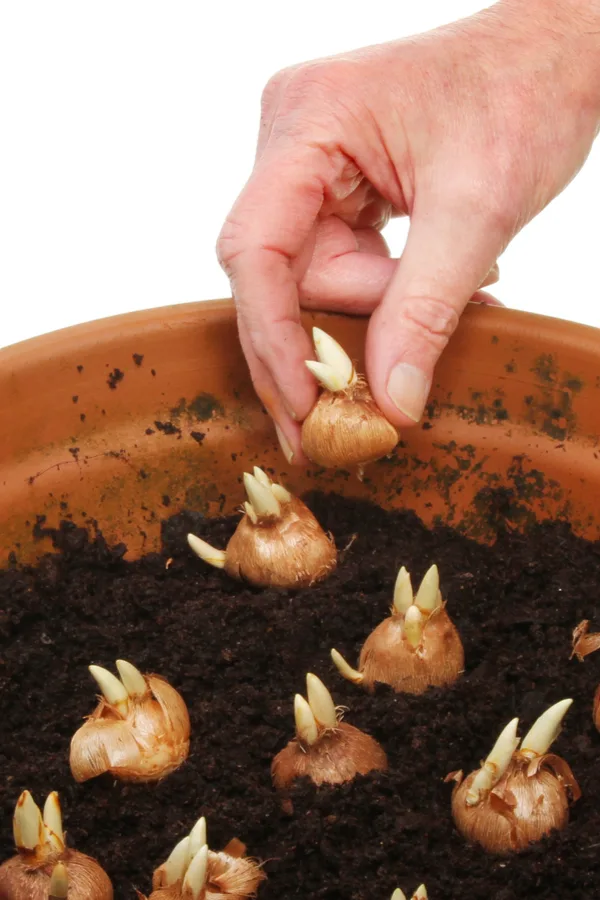
Planting Corms In The Fall
For locations with colder winters, aim for getting the corms in the ground around 6 to 8 weeks before your first hard freeze date. You can find that date by visiting Here. This allows the crocus plants to get their roots established before going dormant in the winter.
Choose a location that receives full sun. Crocus flowers can grow with partial shade, but they prefer full sun. Also, make sure that the location has very good draining soil.
Dig a hole that is at least 4 inches deep and around 2 to 6 inches wide. You may choose to dig a trench instead of individual holes. A good rule of thumb for how deep to plant is to make your hole 3 times deeper as the corm is high. Add an additional inch to allow the addition of compost. So if your corm is 1 inch high, you would need your hole to be at least 3 inches deep (4 inches if you are adding compost).
Add an inch or two of compost into the hole. Place your crocus corm into the hole with the pointy end up. Backfill with a 50/50 percent mixture of soil and compost. Lightly tamp down the soil and water well.
Crocuses look best when planted in groups of 10 or more. You may choose to add a couple of inches of mulch in order to keep weeds at bay, but that is completely optional.
For Warmer Locations
If your winters do not drop in temperature for a long enough period or if you want to plant crocuses in containers, you may choose to force them indoors.
Choose a container that has good drainage holes and fill it with a multi-purpose potting mix. Place corms just below the surface with the pointy end up. Space additional corms about 3 inches apart if planting multiple per container.
Potted containers do not provide enough insulation to keep corms protected from freezing temperatures. So once temperatures start to drop outside, bring the container into a dry and dark location that stays around 35º to 45º Fahrenheit (1 to 7º Celsius). An unheated garage or basement works perfectly for this.
Do not let the temperatures drop below freezing. Keep corms in this location for at least 13 weeks. There might be some shoot growth, but it will be minimal.
Water sparingly during this time so the soil stays moistened but not saturated. Once the shoots reach around 1 to 2 inches long, you can start to increase the temperature and daylight. When outside temperatures allow, place containers back outdoors or plant crocus in the ground when the soil can be worked in early spring.
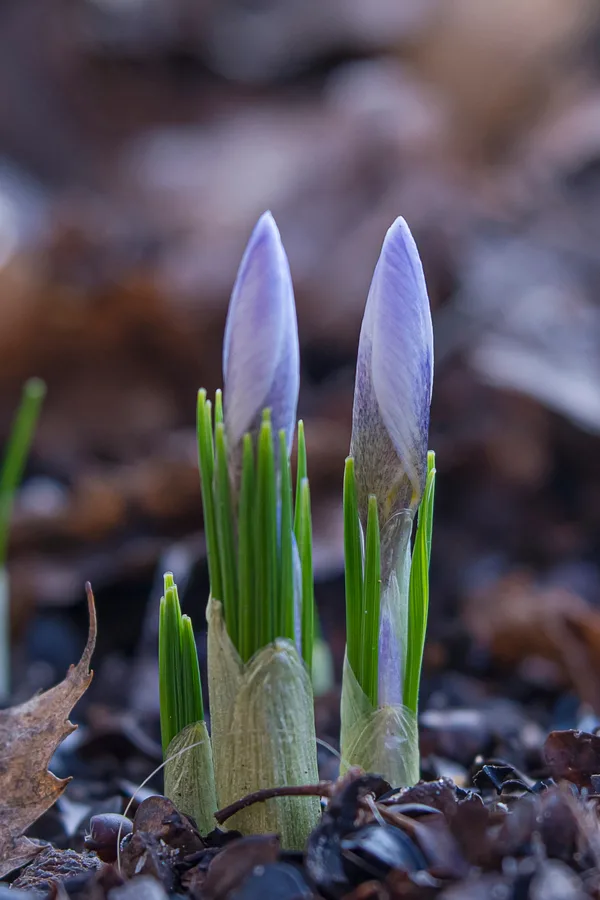
Long-Term Care – How To Grow And Maintain Crocus Flowers
After your initial watering when you plant the corms, you should not need to water crocuses during the fall. The corms will go dormant during the winter months and stay protected from the freezing temperatures if they were planted deep enough.
Once the warmer weather of spring arrives and the daylight hours start to extend some, the shoots will start to come up through the soil. This is typically around March for many locations, although some varieties of crocuses will grow later in spring.
Watering
As with most flowers that grow from bulbs, tubers, or corms, crocuses are very susceptible to overly wet soil. Water very sparingly in the spring and only when the soil is dry 3 inches below the surface. Take care not to water overhead with a sprinkler or sprayer. Instead, water at the base of the flowers when possible.
Fertilizing
You can fertilize with a light dose of 5-10-5 or 10-10-10 fertilizer to help assist with blooming. There are also commercial fertilizers that are made specifically for bulbs and corms.
Pests & Issues
As mentioned earlier, crocuses are prone to issues associated with overly wet soil. Diseases such as gray mold and bulb rot are common if the soil remains wet for too long.
In addition to those issues, crocus corms are targets for pests like squirrels, chipmunks, or mice. These animals love to dig up and dine on the corms. Check out this article on How To Protect Bulbs From Squirrels & Chipmunks to find out ways to deter this from happening.
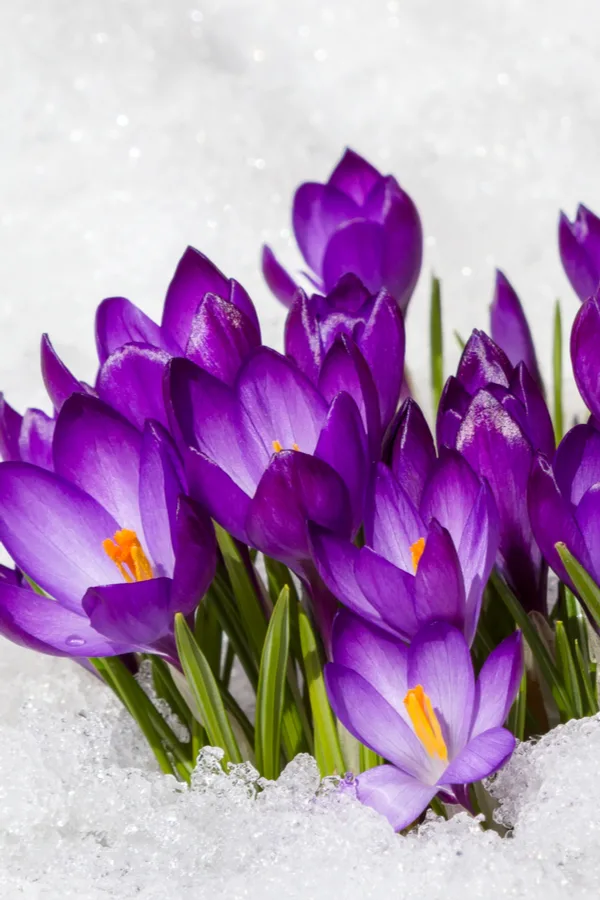
Pruning
After the blooms of the crocus plants start to fade in late spring, you can remove the dying blooms. However, take care to leave the remaining foliage on the plant. The foliage will provide nutrients to the corms for next year’s blooms. Once the foliage dies off and turns brown naturally, you can then cut it back completely.
Crocus corms can remain in the ground as long as your winter temperatures drop below 50º Fahrenheit (10º Celsius). In some locations, they will naturalize and multiply. In other locations, you might have to treat them as annuals and replant every few years.
Either way, every 3 to 4 years, dig up the corms to avoid overcrowding. Choose only the best corms to replant again in the fall, making sure to space them out properly.
To Conclude…
Crocuses are a great addition to any garden or landscape area where you are looking to add bursts of color to those early spring days!
Feel free to download, print out, or save our Crocus At-A-Glance sheet. It is sized for half letter printing but can be scaled if needed.
